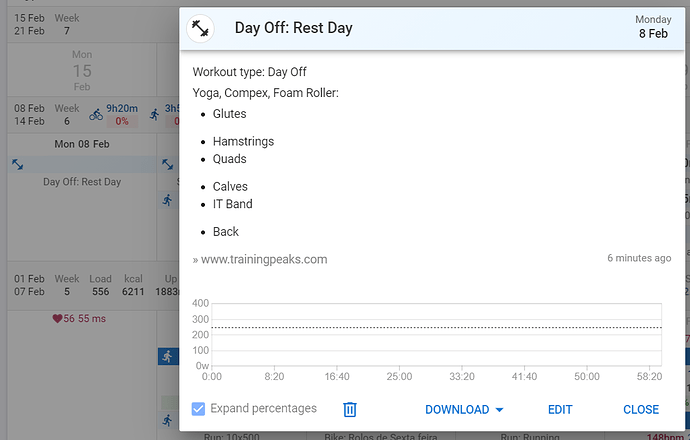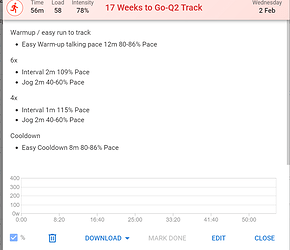Yes you can add a note or as Calum suggests just leave them empty.
@david seeing as you’re probably not too busy, QOL one for you.
Appears you cannot scroll through workout lists on mobile when trying to add to calendar. Any attempt to scroll ends up dragging the workout rather than moving through the list.
 I probably need to keep a space on the right hand side open for scrolling … will have to experiment.
I probably need to keep a space on the right hand side open for scrolling … will have to experiment.
Question Hi would anyone know what is the difference between fatigue and soreness?
not that it really matters… just curious …
The metrics that is included of soreness and fatigue and mood… are they based on any protocol? If there are any links for me to explore, that be wonderful
Here are some Links I googled
//
Muscle fatigue typically arises from exercise that involves “concentric contractions” (where the muscle is shortening) and no impact with the ground such as swimming and cycling.
“You can swim for hours, you can cycle for hours. And you burn fuel, but you don’t really get super sore, you get more tired,” Dr Halson said.
Muscle soreness, on the other hand, comes about after exercise that involves the lengthening of muscles.
This can break the connections between muscle fibres, causing inflammation and swelling.
“That swelling causes the soreness,” Dr Halson explained.
//
2. Perceived Soreness (0 – 10 Scale)
For me, perceived soreness is more a measure of muscular fatigue that relates to the training the day before. Whether it results from training skills, routines, strength, or cardio, overall levels of soreness are really important. I describe this to athletes as physical soreness, with 0 being absolutely fine, and 10 being cripplingly sore. For one, it gives insight into how athletes responded to the last day or days of cumulative training. Secondarily, I think it also gives psychological insight into how a gymnast may approach the day of training ahead.
It’s inevitable that gymnasts will be sore from hard training, and in a way we want this to occur to make sure adaptation is being chased. Remember, the proper implementation of training can enhance performance and also be protective against injury as fitness develops. However, we need to keep a very close eye on too high of soreness levels, global fatigue sparking overtraining syndrome, and overuse injury risk escalating.
From being an athlete myself, coaching a lot of athletes, and seeing many gymnasts for medical-based rehab, this aspect can be really important to understanding whats going on.
3. Perceived Fatigue (0-10 Scale)
In parallel to soreness levels above, I also have gymnasts give a perceived rating of global fatigue. In my mind, this is less of a physical measure of soreness and more of a mental measure of how “drained” a gymnast feels. For me, the soreness levels reflect the actual training – recovery cycles. I feel the perceived fatigue factors in much more global stress levels. This can include school work, family life, friends, and other stressors that factor into the global stress response.
//
The issue of having a no icon or no option for rest day is when you import the calendar from TP, you have a custom icon workout
Thanks
But that is a workout, not really a rest day?
It’s a really a rest day. That’s just my description to remind me how to recover better today. Image from TP

Aha. So I need to add “Rest day” as an activity type for TP import. Got it now.
Or I could just ignore “Rest Day”'s on import?
I think it is better to add a Rest day as an activity type because for me is different a rest day than a skipped or empty day.
Thanks
Hi David, is it possible to duplicate a plan?
Let’s say a coach has made a 12hr/week plan but wants to make a tweaked version for 8hr/week athletes. Could you duplicate the entire plan and then edit the workouts within it?
I have that on the todo list already. Unfortunately you can’t do it right now 
Thanks David, no worries.
And do I understand right that at the moment, if an athlete wanted to do the workouts in Zwift, they would need to download them as a ZWO, save it in their Zwift workouts folder, and then select the workout from the custom folder?
Yes as far as I know.
Hi David. Is there a way to copy a whole week instead of copying the workouts one by one when creating a plan?
Yes. You can create a plan with just a week worth of workouts and drop it on another plan. Thats not ideal. I am going to be doing some work to make this easier very soon (duplicate week etc.).
Hi @david ,
I’m getting a wee glitch when creating and pushing running plan workouts.
The running workout within the plan creator page looks great as below
But when I look at it in one of my athletes calendars it seems to ignore the “Pace” indicator and force the the workout graph to be in watts, see below. I can edit the workout manually within their calendar to show “HR” indicator graphs but it doesn’t seem recognise “Pace” at all
Edit: I should say that it is like this with all workouts within the plan the above are just examples of a single workout.
Does the athlete have pace setup in /settings for the sport? Also there is a setting to control how workouts on an athletes calendar are done (“Workouts”):
Ah… that’s exactly the issue . Cheers!
Anyone know if it’s possible to push individual weeks of a plan to athletes without pushing all other weeks at the same time?
I’m making manual changes to the overall plan for individual athletes within their athlete calendar but I’ve come across an issue where if I make changes in the “mother” plan and “apply changes” it overwrites the manual changes I’ve made to individuals.
Not at the moment. But adding “Apply to athletes” to the week menu for a plan is a good idea.



